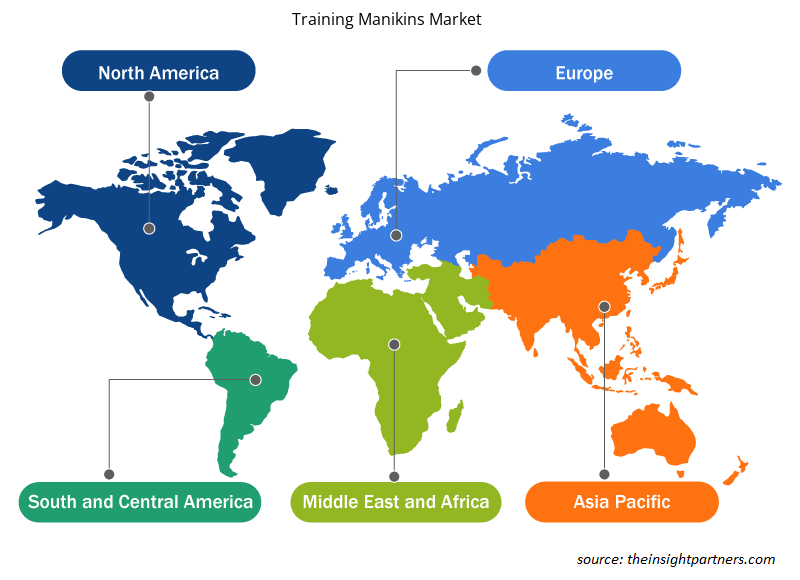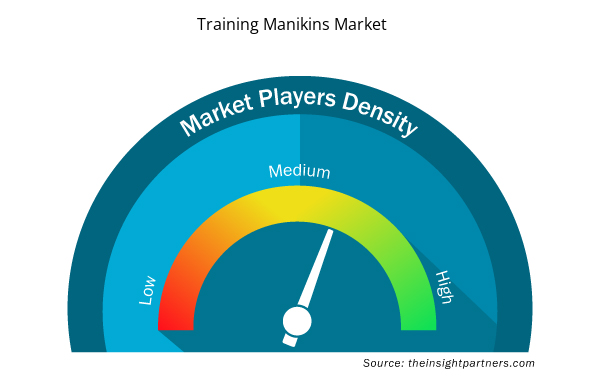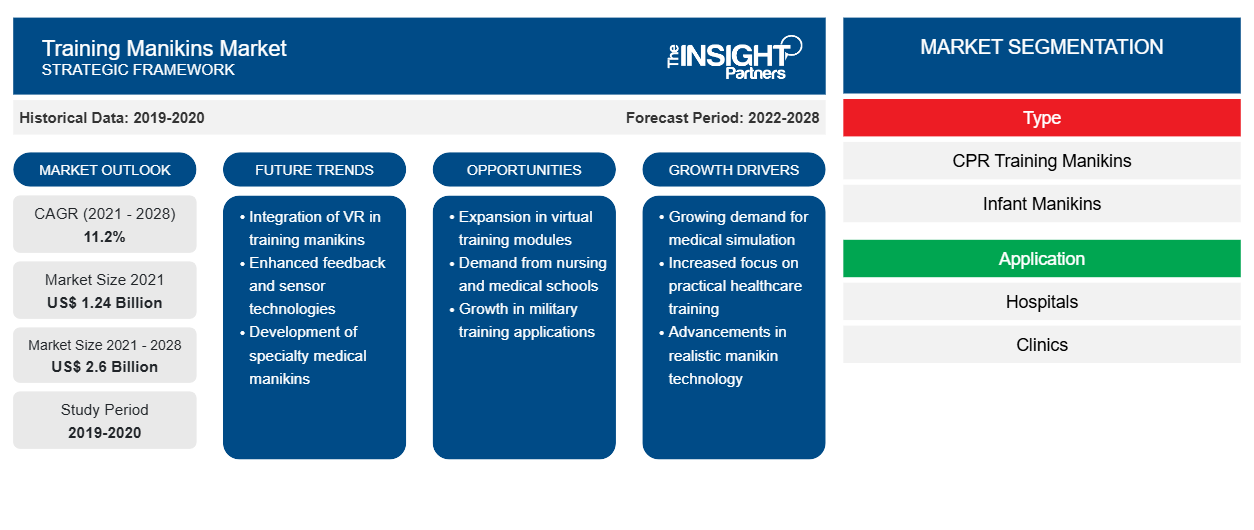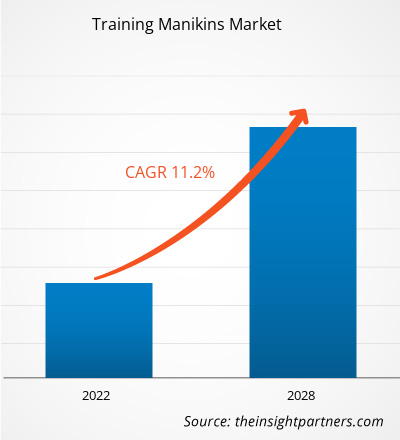Si prevede che la dimensione del mercato dei manichini didattici raggiungerà i 2.603,89 milioni di dollari entro il 2028, rispetto ai 1.235,61 milioni di dollari del 2021. Si stima che la dimensione del mercato globale dei manichini didattici crescerà a un CAGR dell'11,2% nel periodo 2021-2028.CAGR of 11.2% during 2021–2028.
I manichini di addestramento sono una replica di un adulto, bambino o neonato con vie aeree, organi o sistemi di organi simulati. Sono utilizzati per insegnare e addestrare alla RCP, alla gestione avanzata delle vie aeree e alle procedure chirurgiche. I manichini di addestramento possono essere a figura intera o avere solo le parti del corpo rilevanti necessarie per l'addestramento o la dimostrazione. I manichini di addestramento sono stati utilizzati fin dagli anni '50 per la dimostrazione e l'addestramento all'esecuzione della RCP. L'uso della robotica e di altre tecnologie ha ulteriormente migliorato il feedback reattivo dei manichini, che ha contribuito a migliori esperienze di apprendimento.
La crescita del mercato dei manichini di addestramento è attribuita al progresso nella tecnologia dei manichini di addestramento e all'aumento degli arresti cardiaci extraospedalieri in tutto il mondo. Tuttavia, i problemi relativi al realismo dei manichini di addestramento potrebbero ostacolare la crescita del mercato dei manichini di addestramento nel periodo di previsione.
Personalizza questo report in base alle tue esigenze
Riceverai la personalizzazione gratuita di qualsiasi report, comprese parti di questo report, o analisi a livello nazionale, pacchetto dati Excel, oltre a usufruire di grandi offerte e sconti per start-up e università
- Scopri le principali tendenze di mercato in questo rapporto.Questo campione GRATUITO includerà analisi di dati che spaziano dalle tendenze di mercato alle stime e alle previsioni.
Approfondimenti di mercato
L'aumento della prevalenza di arresti cardiaci extraospedalieri e dei programmi di formazione e sensibilizzazione sulla rianimazione cardiopolmonare (RCP) stimola il mercato dei manichini per l'addestramento
Uno studio, intitolato "The Global Survival Rate Among Adult Out-Of-Hospital Cardiac Arrest Patients Who Received Cardiopulmonary Resuscitation: A Systematic Review and Meta-Analysis", pubblicato nel 2020, ha valutato i tassi di sopravvivenza dei pazienti OHCA, che hanno ricevuto RCP da un passante o dai servizi medici di emergenza e vivevano in una determinata regione. Lo studio ha riportato un aumento significativo dei tassi di sopravvivenza da OHCA negli ultimi anni e i tassi sono maggiori tra i pazienti che hanno ricevuto RCP e vivevano nei paesi occidentali. Uno degli usi più comuni dei manichini di addestramento è la formazione sulla RCP. Le malattie cardiovascolari (CVD) sono la principale causa di morbilità e mortalità a livello globale. L'Organizzazione mondiale della sanità (OMS) stima che 17,9 milioni di vite vengano perse a causa di CVD, ovvero il 32% di tutti i decessi viene segnalato a livello globale ogni anno. Quattro su cinque decessi correlati a CVD sono dovuti ad infarti e ictus. La consapevolezza riguardo alla rianimazione cardiopolmonare (RCP) è elevata nei paesi occidentali. Nel 2019 si sono verificati in Europa e negli Stati Uniti circa 700.000 casi di arresto cardiaco extraospedaliero (OHCA), con una percentuale significativa di questi verificatisi a casa e in luoghi pubblici. Inoltre, ad esempio, nel Regno Unito è stato introdotto un programma di formazione dalla Advanced Coronary Treatment (ACT) Foundation per studenti delle scuole secondarie associati ai British Columbia Emergency Health Services (BCEHS). I volontari paramedici formano gli insegnanti per istruire gli studenti presso i BCEHS. In alcune università, i BCEHS stanno pianificando di implementare la formazione sui manichini di addestramento come parte del curriculum di educazione fisica. "Nation of Lifesavers – Call, Push, Rescue" della British Heart Foundation è un altro esempio di programma di formazione semplificato che si concentra sulla RCP con sola compressione e sul DAE. La British Heart Foundation ha anche assunto la guida nel mobilitare i professionisti medici per supportare l'istruzione pubblica nel Regno Unito. Nel complesso, con programmi di sensibilizzazione e formazione organizzati da enti governativi e locali, il mercato dei manichini di addestramento sta assistendo a una crescita costante.OHCA patients, who received CPR from a bystander or OHCA in the past years, and the rates are greater among patients who received CPR and were living in western countries. One of the most common uses of training manikins is giving CPR training. Cardiovascular diseases (CVDs) are the leading cause of morbidity and mortality globally. The World Health Organization (WHO) estimates 17.9 million lives are lost due to CVDs, i.e., 32% of all deaths are reported globally every year. Four out of five CVD-related mortalities are due to heart attacks and strokes. The awareness regarding cardiopulmonary resuscitation (CPR) is high in western countries. ~700,000 cases of out-of-hospital cardiac arrest (OHCA) occurred in Europe and the US in 2019, with a significant percentage of these occurring at home and in public settings. Moreover, for instance, a training program was introduced in the UK by the Advanced Coronary Treatment (ACT) Foundation for secondary school students associated with British Columbia Emergency Health Services (BCEHS). Paramedic volunteers train teachers to educate students at BCEHS. In certain universities, BCEHS is planning to implement Training Manikins training as a part of the physical education curriculum. The British Heart Foundation’s “Nation of Lifesavers – Call, Push, Rescue” is another example of a simplified training program that focuses on compression-only CPR and AED. The British Heart Foundation has also taken the lead in rallying medical professionals to support public education in the UK. Overall, with awareness and training programs organized by governmental and local bodies, the training manikins market is witnessing steady growth.
Informazioni basate sul tipo
In base al tipo, il mercato globale dei manichini per l'addestramento è stato segmentato in manichini per l'addestramento alla RCP, manichini per neonati e altri. È probabile che il segmento dei manichini per l'addestramento alla RCP deterrà la quota maggiore del mercato dei manichini per l'addestramento nel 2021. Si prevede che il segmento dei manichini per l'addestramento alla RCP assisterà al CAGR più rapido, ovvero dell'11,7% tra il 2021 e il 2028 a causa dell'aumento dell'arresto cardiaco improvviso extraospedaliero (OHCA) con rianimazione cardiopolmonare (RCP) inefficace, terza causa di morte nel mondo.CAGR, that is, of 11.7% between 2021 and 2028 due to the rise in sudden out-of-hospital cardiac arrest (OHCA) with ineffective cardiopulmonary resuscitation (CPR) is the third greatest cause of death across the world.
Approfondimenti regionali sul mercato dei manichini per l'addestramento
Le tendenze regionali e i fattori che influenzano il Training Manikins Market durante il periodo di previsione sono stati ampiamente spiegati dagli analisti di Insight Partners. Questa sezione discute anche i segmenti e la geografia del Training Manikins Market in Nord America, Europa, Asia Pacifico, Medio Oriente e Africa e Sud e Centro America.

- Ottieni i dati specifici regionali per il mercato dei manichini di formazione
Ambito del rapporto di mercato sui manichini di formazione
| Attributo del report | Dettagli |
|---|---|
| Dimensioni del mercato nel 2021 | 1,24 miliardi di dollari USA |
| Dimensioni del mercato entro il 2028 | 2,6 miliardi di dollari USA |
| CAGR globale (2021 - 2028) | 11,2% |
| Dati storici | 2019-2020 |
| Periodo di previsione | 2022-2028 |
| Segmenti coperti | Per tipo
|
| Regioni e Paesi coperti | America del Nord
|
| Leader di mercato e profili aziendali chiave |
|
Manichini di formazione Densità degli attori del mercato: comprendere il suo impatto sulle dinamiche aziendali
Il mercato dei manichini per l'addestramento sta crescendo rapidamente, spinto dalla crescente domanda degli utenti finali dovuta a fattori quali l'evoluzione delle preferenze dei consumatori, i progressi tecnologici e una maggiore consapevolezza dei vantaggi del prodotto. Con l'aumento della domanda, le aziende stanno ampliando le loro offerte, innovando per soddisfare le esigenze dei consumatori e capitalizzando sulle tendenze emergenti, il che alimenta ulteriormente la crescita del mercato.
La densità degli operatori di mercato si riferisce alla distribuzione di aziende o società che operano in un particolare mercato o settore. Indica quanti concorrenti (operatori di mercato) sono presenti in un dato spazio di mercato in relazione alle sue dimensioni o al valore di mercato totale.
Le principali aziende che operano nel mercato dei manichini didattici sono:
- Ambu, Inc.
- Azienda scientifica Gaumard, Inc.
- Azienda medica Laedral A/S
- Risorse salvavita, Inc.
- Tecnologie per l'istruzione medica, Inc.
Disclaimer : le aziende elencate sopra non sono classificate secondo un ordine particolare.

- Ottieni la panoramica dei principali attori del mercato dei manichini di formazione
Approfondimenti basati sulle applicazioni
In base all'applicazione, il mercato globale dei manichini didattici è segmentato in ospedali, cliniche e altri. È probabile che il segmento Ospedali deterrà la quota maggiore del mercato nel 2021. Inoltre, si prevede che il segmento assisterà anche a una crescita della sua domanda al CAGR più rapido, ovvero dell'11,8% durante il periodo dal 2021 al 2028 a causa dell'aumento dell'utilizzo di manichini didattici negli ospedali di tutto il mondo.
I lanci e le approvazioni di prodotti sono strategie comunemente adottate dalle aziende per espandere la loro presenza globale e i portafogli di prodotti per dominare la quota di mercato dei manichini di formazione. Inoltre, gli operatori del mercato dei manichini di formazione si concentrano sulla strategia di partnership per ampliare la loro clientela, il che, a sua volta, consente loro di mantenere il loro marchio in tutto il mondo. Si prevede che la quota di mercato dei manichini di formazione prospererà con lo sviluppo di nuovi prodotti innovativi da parte degli operatori del mercato dei manichini di formazione.
Profili aziendali
- Ambu, Inc
- Azienda scientifica Gaumard, In
- Azienda medica Laedral A/S
- Risorse salvavita, Inc.
- Tecnologie per l'istruzione medica, Inc.
- Simulaids, Inc.
- La Aristotle Corp.
- Rianimazione cardiopolmonare americana
- Nasco
- Società
- Analisi storica (2 anni), anno base, previsione (7 anni) con CAGR
- Analisi PEST e SWOT
- Valore/volume delle dimensioni del mercato - Globale, regionale, nazionale
- Industria e panorama competitivo
- Set di dati Excel


- Military Rubber Tracks Market
- Virtual Production Market
- Electronic Data Interchange Market
- Dry Eye Products Market
- Wire Harness Market
- Airport Runway FOD Detection Systems Market
- Embolization Devices Market
- Aircraft Landing Gear Market
- Retinal Imaging Devices Market
- Saudi Arabia Drywall Panels Market

Report Coverage
Revenue forecast, Company Analysis, Industry landscape, Growth factors, and Trends

Segment Covered
This text is related
to segments covered.

Regional Scope
North America, Europe, Asia Pacific, Middle East & Africa, South & Central America

Country Scope
This text is related
to country scope.
Domande frequenti
The factors that are driving the growth of the market are the advancements in the technologies used in the development of manikins and the increasing prevalence of out-of-hospital cardiac arrests and cardiopulmonary resuscitation training and awareness programs. Moreover, the training for COVID-19 pandemic and the use of remote training have provided growth opportunities to the market.
The training manikins market majorly consists of the players such as Ambu, Inc., Gaumard Scientific Company, Inc., Laedral Medical A/S, Simulaids, Inc., American CPR, Nasco Healthcare, TruCorp., and CAE Inc., among others.
Training manikins are a replica of an adult, child, or infant human with simulated airways, organs, or organ systems. These are used for teaching and training of CPR, advanced airway management, and surgical procedures. Training manikins can be full-body or have only the relevant body parts necessary for the training or demonstration. As technology has developed, the training manikins have become more sophisticated with airways, organs, and organ systems that resemble the human anatomical systems that have been made to provide a high-fidelity experience to the user. The use of robotics and other technologies has further improved the responsive feedback of the manikins which have aided in better learning experiences.
Trends and growth analysis reports related to Life Sciences : READ MORE..
The List of Companies - Training Manikins market
- Ambu, Inc.
- Gaumard Scientific Company, Inc
- Laedral Medical A/S
- LifeSaving Resources, Inc.
- Medical Education Technologies, Inc.
- Simulaids, Inc.
- The Aristotle Corp.
- American CPR
- Nasco
- TruCorp.
The Insight Partners performs research in 4 major stages: Data Collection & Secondary Research, Primary Research, Data Analysis and Data Triangulation & Final Review.
- Data Collection and Secondary Research:
As a market research and consulting firm operating from a decade, we have published and advised several client across the globe. First step for any study will start with an assessment of currently available data and insights from existing reports. Further, historical and current market information is collected from Investor Presentations, Annual Reports, SEC Filings, etc., and other information related to company’s performance and market positioning are gathered from Paid Databases (Factiva, Hoovers, and Reuters) and various other publications available in public domain.
Several associations trade associates, technical forums, institutes, societies and organization are accessed to gain technical as well as market related insights through their publications such as research papers, blogs and press releases related to the studies are referred to get cues about the market. Further, white papers, journals, magazines, and other news articles published in last 3 years are scrutinized and analyzed to understand the current market trends.
- Primary Research:
The primarily interview analysis comprise of data obtained from industry participants interview and answers to survey questions gathered by in-house primary team.
For primary research, interviews are conducted with industry experts/CEOs/Marketing Managers/VPs/Subject Matter Experts from both demand and supply side to get a 360-degree view of the market. The primary team conducts several interviews based on the complexity of the markets to understand the various market trends and dynamics which makes research more credible and precise.
A typical research interview fulfils the following functions:
- Provides first-hand information on the market size, market trends, growth trends, competitive landscape, and outlook
- Validates and strengthens in-house secondary research findings
- Develops the analysis team’s expertise and market understanding
Primary research involves email interactions and telephone interviews for each market, category, segment, and sub-segment across geographies. The participants who typically take part in such a process include, but are not limited to:
- Industry participants: VPs, business development managers, market intelligence managers and national sales managers
- Outside experts: Valuation experts, research analysts and key opinion leaders specializing in the electronics and semiconductor industry.
Below is the breakup of our primary respondents by company, designation, and region:

Once we receive the confirmation from primary research sources or primary respondents, we finalize the base year market estimation and forecast the data as per the macroeconomic and microeconomic factors assessed during data collection.
- Data Analysis:
Once data is validated through both secondary as well as primary respondents, we finalize the market estimations by hypothesis formulation and factor analysis at regional and country level.
- Macro-Economic Factor Analysis:
We analyse macroeconomic indicators such the gross domestic product (GDP), increase in the demand for goods and services across industries, technological advancement, regional economic growth, governmental policies, the influence of COVID-19, PEST analysis, and other aspects. This analysis aids in setting benchmarks for various nations/regions and approximating market splits. Additionally, the general trend of the aforementioned components aid in determining the market's development possibilities.
- Country Level Data:
Various factors that are especially aligned to the country are taken into account to determine the market size for a certain area and country, including the presence of vendors, such as headquarters and offices, the country's GDP, demand patterns, and industry growth. To comprehend the market dynamics for the nation, a number of growth variables, inhibitors, application areas, and current market trends are researched. The aforementioned elements aid in determining the country's overall market's growth potential.
- Company Profile:
The “Table of Contents” is formulated by listing and analyzing more than 25 - 30 companies operating in the market ecosystem across geographies. However, we profile only 10 companies as a standard practice in our syndicate reports. These 10 companies comprise leading, emerging, and regional players. Nonetheless, our analysis is not restricted to the 10 listed companies, we also analyze other companies present in the market to develop a holistic view and understand the prevailing trends. The “Company Profiles” section in the report covers key facts, business description, products & services, financial information, SWOT analysis, and key developments. The financial information presented is extracted from the annual reports and official documents of the publicly listed companies. Upon collecting the information for the sections of respective companies, we verify them via various primary sources and then compile the data in respective company profiles. The company level information helps us in deriving the base number as well as in forecasting the market size.
- Developing Base Number:
Aggregation of sales statistics (2020-2022) and macro-economic factor, and other secondary and primary research insights are utilized to arrive at base number and related market shares for 2022. The data gaps are identified in this step and relevant market data is analyzed, collected from paid primary interviews or databases. On finalizing the base year market size, forecasts are developed on the basis of macro-economic, industry and market growth factors and company level analysis.
- Data Triangulation and Final Review:
The market findings and base year market size calculations are validated from supply as well as demand side. Demand side validations are based on macro-economic factor analysis and benchmarks for respective regions and countries. In case of supply side validations, revenues of major companies are estimated (in case not available) based on industry benchmark, approximate number of employees, product portfolio, and primary interviews revenues are gathered. Further revenue from target product/service segment is assessed to avoid overshooting of market statistics. In case of heavy deviations between supply and demand side values, all thes steps are repeated to achieve synchronization.
We follow an iterative model, wherein we share our research findings with Subject Matter Experts (SME’s) and Key Opinion Leaders (KOLs) until consensus view of the market is not formulated – this model negates any drastic deviation in the opinions of experts. Only validated and universally acceptable research findings are quoted in our reports.
We have important check points that we use to validate our research findings – which we call – data triangulation, where we validate the information, we generate from secondary sources with primary interviews and then we re-validate with our internal data bases and Subject matter experts. This comprehensive model enables us to deliver high quality, reliable data in shortest possible time.


 Ottieni un campione gratuito per questo repot
Ottieni un campione gratuito per questo repot